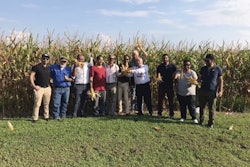Saudi Arabian corn buyers in Minnesota, Mexican sorghum buyers in Texas, Japanese food barley buyers to Idaho, Nigerian legislators on the Eastern Shore of Maryland — these represent only a handful of the trade teams from around the world that will transverse the United States this summer and fall.
Organized by the U.S. Grains Council (USGC) with support from our members, each team has a slightly different goal — examining the quality of this year’s crops, discussing logistical advantages and options, checking in on contracted production and learning about advanced breeding techniques, just to name a few. But all serve the Council’s larger goals of developing markets, enabling trade and improving lives.
Trade teams offer the opportunity to meet face-to-face with the farmers and agribusinesses who grow and produce the coarse grains and co-products sold around the world.
These visits also expose participants to the entirety of the U.S. grain transportation system, including rail, barge and export facilities
Beyond the fundamentals of the U.S. grain supply chain, trade teams illustrate the varied audiences the Council works with overseas to promote exports. From maintaining large and loyal customers to diversifying markets when major disruptions occur, the Council’s connections are constantly evolving to match the opportunities and the advantages of U.S. agriculture in a growing and increasingly competitive world market.
Promoting U.S. advantage to world grain buyers
The largest, and most logical, target audience for the Council is grain trading and importing companies, which buy coarse grains and co-products from the United States and its competitors and re-sell those goods to end-users in livestock, poultry, dairy and egg producing sectors.
These buyers are highly sophisticated and well-connected, following the market as closely as the Council. As a result, the Council must engage with grain traders and buyers on the same level, rather than focus on pure market fundamentals.
And, as younger generations of traders and buyers enter the workforce, the Council also works to establish new relationships within old trading partners. Trade teams offer the opportunity to answer specific questions from sophisticated buyers and provide this education to new market players.
A team of Mexican grain importers and feed millers from the National Association of Food Manufacturers for Animal Consumption (ANFACA) visited Texas and Kansas in June 2018. Participants represented younger members from these buyers and traveled to the United States to specifically see the U.S. sorghum value chain — from crops in the field to elevators and port facilities. Doing so increases their knowledge and trust in the grain chain and helps continue sales to this important market.
Dealing directly with feed companies
In many markets, feed companies that had worked principally with trading companies to purchase feed ingredients have grown large enough to import their own supplies. Doing so saves the company money and allows them to purchase coarse grains and co-products that meet their own nutritional requirements, rather than purchasing from a grain buyer or importer that must meet the needs of several companies.
Feed companies that directly import comprise an entirely new set of buyers the Council works to educate on how the U.S. grain production, transportation and marketing system functions — and their education is complemented by trade team visits to the United States. In Morocco, the Council has shifted from working only with trading companies to also bringing these large and growing feed companies to the United States to build demand.
The Council brings teams of feed companies to the United States either as a group or representing a single company. A team composed of individuals from a single company has a much different dynamic than pure market education. Team members are able to have more in-depth conversations and talk more strategically when their competitors are not sitting on the same bus. Doing so allows the Council to target these leaders in the market and address their unique issues and concerns while building an example for other companies to follow.
Opportunities with containers
The growth in containerized shipping has also provided new opportunities where the price or logistics of containers works more efficiently than larger, bulk shipments of a single commodity. Particularly for some feed companies, buying 500 or 1,000 tons in containers directly for their own use can make a lot of sense in terms of logistics and specifications.
Before 2005, it was nearly unheard of to import grain via container and doing so was prohibitively expensive. However, the idea of shipping corn, distiller’s dried grains with solubles (DDGS) or other products in containers slowly caught on, versus the practice at that time of shipping containers that arrived in the United States back overseas empty. Now, the market is thriving and international companies that have a niche in selling products via container have joined the Council as member to increase their business and take advantage of these markets.
The Council can use trade team visits to the United States to introduce even long-time buyers interested in containers to these originators and exporters. In 2008, rates in the bulk freight market skyrocketed. As a result, some large markets like Taiwan started to import corn via containers. Taiwan imported 65% of corn imports in containers that year and continues to import a portion of the U.S. corn it purchases by container.
Buying groups join together for purchasing decisions
In other markets, feed companies or end-users have formed buying groups to make joint purchasing decisions. These sales are all conducted privately, but require the Council to focus on what the group or its key influencers need or want, versus working with individual companies.
In South Korea, the buying group makes the vast majority of decisions for importing U.S. corn. In 2017, this group decided to change specifications on their tenders to set a price based on BCFM (broken corn and foreign material) percentage at the destination port in South Korea, which resulted in no U.S. offers on the tenders. Both a South Korean feed buying and industrial corn buying group traveled to the United States and walked through the entirety of the U.S. grain supply chain from the farmer to the export facility.
After meeting with exporters and examining the importance of maintaining quality throughout the value chain, the buying groups dropped this clause in their tenders and the flow of corn between the United States and South Korea resumed.
Targeting high-value markets
While the majority of trade teams visiting the United States represent large, bulk commodities, the Council also works to bring teams representing niche industries or specialty uses to maintain and grow these high-value markets.
U.S. barley producers and the Mexican beer industry represent one of these high-value markets.
The brewing industry in Mexico is growing strongly with many major companies making substantial investments in new brewing, malting and bottle manufacturing plants. These investments represent additional demand and opportunities to strengthen existing supply relationships with U.S. producers and exporters, if the duty-free trading relationship established under the North American Free Trade Agreement (NAFTA) continues unhindered.
To strengthen existing relationships and continue developing opportunities with both large-scale and smaller, craft brewers, the Council organizes annual brewing industry teams to travel to barley producing states to meet with U.S. barley farmers and see firsthand how this top ingredient is grown and malted to ensure continued contract arrangements to grow malting barley in the United States for Mexican barley continues.
Ensuring market access
None of these interactions would be possible, however, without government-to-government interactions that ensure continued market access. As a result, the Council also works directly with government officials and regulators overseas. In country, the Council has established strong relationships with local governments, but bringing those officials to the United States allows for continuous discussions and elongated work on specific subject matters.
Some of these government teams are attempting to overcome specific policy issues in place. In these cases, the Council often pairs government officials with their own industry players, who reinforce the need to address these problems.
Following the detection of quarantined pests, the Vietnamese Plant Protection Department (PPD) issued a decision in October 2016 to temporarily suspend DDGS importation. Along with the U.S. Department of Agriculture’s Animal and Plant Health Inspection Service (USDA’s APHIS) and the Office of the U.S. Trade Representative (USTR) and local industry members in Vietnam, the Council arranged a team from PPD to travel to the United States to further explore solutions. Within a month of the team’s visit, a protocol was put into place that addressed the Vietnamese government’s concerns and help return open access to one of the fastest growing feed markets in the world.
Regulators, like the ones from Vietnam, are an important audience beyond market disruptions. The Council also works with these officials while policies are still being drafted. Bringing these teams to the United States can head off interruptions that would inhibit the flow of trade.
In 2013, the Colombian government was considering changing biotech regulations in a way that would have negatively impacted U.S. corn exports. The Council organized a team, which included the specific regulator writing the regulation, to the United States with members from the Colombian industry. By the fourth day, she realized the trickle-down impact of the regulation she was authoring and revised the provision, preventing a market disruption.
The Council also arranges for regular teams of government regulators responsible for the approval of biotech traits from large markets like Japan, South Korea and Taiwan. In a similar fashion, the Council arranges teams of regulatory reviewers. These reviewers are researchers or consultants working with government regulators to make determinations on approvals or regulations. These folks may know little about corn production, but their recommendations could slow down the entire approval or regulatory process.
The Council is arranging for both a regulator and a reviewer team from Japan to travel to the United States this year. Keeping these parties informed as to what to expect from seed technology providers for new traits, staying in touch with counterparts at USDA’s APHIS and other related discussions maintains a smooth approval process that keeps trade flowing to these large markets.
Canvassing the country’s coarse grain production
In addition to focusing on individual teams, the Council is coordinating multiple trade teams in conjunction with the 2018 Export Exchange in October 2018. The Council, the Renewable Fuels Association (RFA) and Growth Energy will welcome domestic suppliers, international buyers and end-users of U.S. feed grains and co-products at this biennial event to make connections that will build and sustain business in the grain trade for years to come.
More than 300 U.S. farmers and agribusiness representatives and an estimated 200 international purchasers and end-users are expected to attend. Because these buying groups are already in the United States, the Council sponsors trade teams from more than 30 countries to participate in tours before and after the main conference. These tours take buyers out to the states, introduce them to growers and tie-into the topics discussed at the conference - all of which contribute to sales worth millions of dollars traded either at the conference or immediately before or after.
The Council’s membership welcomes these influencers and decision-makers to the United States and takes time to answer their questions — a role paramount to the Council’s work to maintain existing market share, explore short-term market opportunities and build long-term, loyal customers for U.S. coarse grains and co-products. From the smallest niche market to the world’s largest buyers, each of these visitors represents an additional opportunity for new win-win scenarios for U.S. farmers and agribusinesses. ❚

















